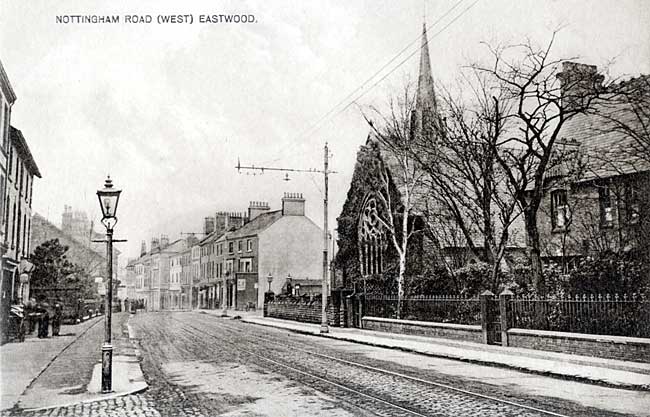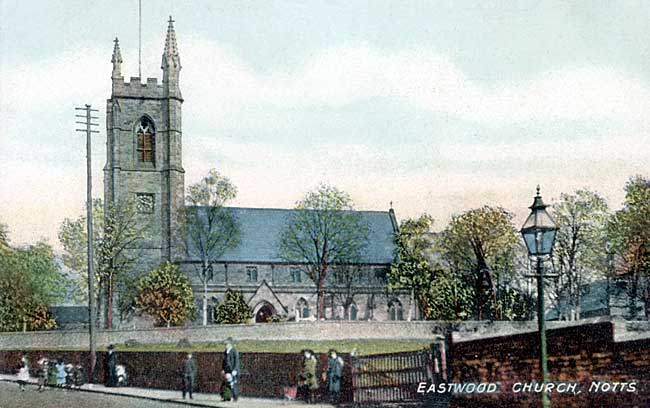Eastwood's Small Beginnings

Nottingham Road (West), Eastwood c.1910.
OF Eastwood's pre-Norman history nothing is definitely known except that its last Danish owner, Ulfchetel, was dispossessed of his little manor of four bovates of land and that it had been assessed to the geld tax at only 5s. This and very little more forms the substance of the Domesday entry except the note that "the land was waste."
It was obviously a small and insignificant hamlet and the name throws little light upon its probable origin. The prefix "East" is Saxon; its old suffix was "thwaite," a forest clearing or a piece cut off, the term being common in the north but rare elsewhere. Prof. Ekwall, an eminent authority, states that the combinations of such Saxon and Old Norse words "mostly relate to places of minor importance of comparatively late origin," and "are rarely names of villages," and this appears to have been the case with Eastwood. It was not until mid-Elizabethan times that the correct terminal of "thwaite" began to be displaced and the name of Eastwood first emerged.
Norman Village
Ulfchetel's infertile soil was apparently not worth giving and in 1086 it was held by Wm. Peverel on behalf of the Conqueror, but it became merged in the Peverel Fee land would revert to the Crown when the last Wm. Peverel fled at the accession of Henry II to be heard of no more though tradition alleges that he found safety awhile as a cowled and tonsured monk of Lenton Priory which his ancestor had founded.
Under Norman sway the village must have developed notably for in 1171 it was contributing the good average sum of 14d. as its Pentecostal offering—twice as much as Cossall and by then Robert de Newthorpe had ceded his rights in Fulwood to Lenton Priory, which presently rounded off the grant by acquiring the rights and claims therein of the Greys of Codnor and others, a passage which shows that the Greys had thus early begun their long tenure here. There was at this period a landholding family named Eastwood mentioned in 1165 and intermittently figuring in the local annals for centuries, one being sherriff in 1240, another being imprisoned at London for unlawful assembly in Nottingham in 1413 and (inter alia) a third goaled as a Quaker in 1676.
A survey of 1250 shows that the Greys then held half a caracute of land in "Eastwick" of the Honour of Peverel, and an inquisition or 1271 recorded that Henry de Grey died seized of the township of "Eastweit" with the site of the old hall, the advowson of the church, and the moiety of a mill. The "old hall" was a capital messuage of the fee and its presence here implies Plantagenet prosperity. The reference to the church is perhaps the earliest reference to it: the date of its erection is unknown out it was probably Norman. In the time of Edward II Sir Richard de Grey forfeited his possessions when he was captured in rebellion at Kenilworth in 1265, but the passage just quoted shows that they had been recovered, doubtless by fine.
Lenton Priory At Law
In 1286 Ranulph de Pascayl and others released to Lenton Priory their rights in the pasture of Fulwood whereupon the prior commenced to enclose the whole wood. The rector of Eastwood sued him for deprivation of his rights but the prior successfully pleaded that Fulwood was extra-parochial, being neither burgh, town (village) or hamlet, and the parson was cast in costs. His second action fared no better for he was nonsuited when the wily prior argued that Fulwood was in Newthorpe where the rector had no rights, it being within the parish of Greasley.
Late in the reign of Edward III the Pascayl third part of the manor went to the Teverys of Stapleford who hold it until 1639 when it descended through an heiress to the Palmes; and in 1379 four men of Eastwood with four others formed what was perhaps the first coal company ever known. They leased land in "Newfield in Newthorpe" from Beauvale Priory at five marks (66s. 8d.) a year with monopoly rights to dig for "sea coal" there.
Local records of the earlier part of the 15th century have little general interest, but mention may be made of an Eastwood grocer and chandler who seems to have had a large business. In 1432 he was sued for "12 marks and 4d. for wax, rosin, and linen-wick" made into torches, candles and tapers, of which some were for religious use. He won that case but was sued for spices and soap in 1436 with unknown result. Near the end of that century Gervase Clifton purchased 50a. of local land in a part known by the strange-looking name of Gresse-brecches. The latter part of this name may be identified with "breac" or "break" — land recently taken into cultivation— but the first part is obscure; possibly it was in some way associated with Greasley.

An early 20th century view of St Mary's Church, Eastwood. The main body of the church was destroyed by fire in the 1960s.
Tudor Times
Following upon the death of the last Lord Grey of Codnor in 1495 arose a complication which baffled Dr. Thoroton who relates that the manor was devised to Grey's bastard sons. The historian adds: "However, I find that after the death of the last Lord Grey this manor was bought of the king by Sir Henry Willoughby." Records now available make it clear that Henry VII purchased that property about 1500 for £1,000 and sold it for £1,400 to Sir Henry Willoughby and John Zouche with an indemity against counter-claims. It is to be remembered that for centuries the manor was divided into three parts, each being known to records as a manor and rendering 10s. yearly to the Crown; the Teverys were still in possession of their manor and in addition the Willoughbys and Zouches there were other local owners. Sir Henry Willoughby sold his share to Sir John Port and by one of the daughters of the latter it was conveyed in marriage, to the Stanhopes.
In 1501 the Strelley inheritance here descended to the Poutrells, but it appears to have returned in whole or part to that family for under James I Sir John Byron claimed lands at Eastwood against Nicholas Strelley and John Mitchell. The village was then growing, and in 1539 seventeen of its men were declared "fit to bear arms." At Bulwell there were only eight, but Annesley boasted 38. Some of them went to the wars, and when Richard Stevyns returned in 1540 from fighting in Ireland he found that his property had been damaged during his absence, but sued for damages in vain.
